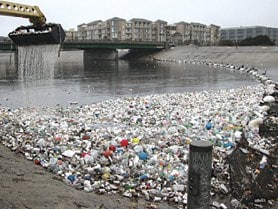Marine debris and litter has become both a significant coastal and open ocean problem. Considerable portions of this debris is made of persistent synthetic materials such as plastics, and is not biodegradable as past product waste has been. Surveys have indicated that nearly 80 percent of marine debris originates from land-based activities.
The increasing influx of people into coastal zones (nearly 50 percent of the U.S. population now lives within 100 miles of the oceans boarding the country or along the shores of the Great Lakes) has exasperated the problem. This trend has increased dependence on processed, manufactured and packaged goods.
Marine debris not only is an aesthetic problem, but has become a serious threat to marine life, a marine transportation hazard, and can threaten human healthy and safety as well as inflict serious economic loss. Estimates of marine life endangered by debris included most of the world’s turtle species, 25 percent of marine mammal species, and more than 15 percent of seabird species. Plastic in water appears as food to many varieties of marine life resulting in often fatal ingestion.
For boats, both commercial and recreational, debris entanglement in motors or water intake valves can prove costly. Human activities such as swimming, diving and simple walks along the beach can also result in injury or entanglement. Debris , especially plastic film and sheeting, can settle over immobile plants and animals including valuable ecosystem habitats such as coral reefs, effectively smothering them and rendering them uninhabitable and unproductive. Reducing waste, promoting recycling, public education efforts, and volunteer coastal monitoring are major means of addressing coastal sources of marine debris.
References
Barreiros, J.P. and J. Barcelos. 2001. Plastic ingestion by a leatherback turtle Dermochelys coriacea from the Azores (NE Atlantic). Marine Pollution Bulletin 42(11): 1196-1197.
Bugoni, L., L. Krause, and M.V. Petry. 2001. Marine debris and human impacts on sea turtles in southern Brazil. Marine Pollution Bulletin 42(12): 1330-1334.
Bullimore, B.A., P.B. Newman, M.J. Kaiser, S.E. Gilbert, and K.M. Lock. 2001. A study of catches in a fleet of ”ghost-fishing” pots. Fishery Bulletin 99(2): 247-253.
Donohue, M.J., R.C. Boland, C.M. Sramek, and G.A. Antonelis. 2001. Derelict fishing gear in the Northwestern Hawaiian Islands: Diving surveys and debris removal in 1999 confirm threat to coral reef ecosystems. Marine Pollution Bulletin 42(12): 1301-1312.
Gregory, M.R., Ryan, P.G. 1997. Pelagic plastics and other seaborne persistent synthetic debris: a review of Southern Hemisphere perspectives.. In Coe, J.M., Rogers, D.B. (Eds.), Marine Debris- Sources, Impacts, Solutions. Springer-Verlag, New York, pp.49-66.
Henderson, J.R. 2001. A pre- and post-MARPOL Annex V summary of Hawaiian monk seal entanglements and marine debris accumulation in the northwestern Hawaiian Islands, 1982-1998. Marine Pollution Bulletin 42(7): 584-589.
Moore, C.J., S.L. Moore, M.K. Leecaster, and S.B. Weisberg. 2001. A comparison of plastic and plankton in the North Pacific central gyre. Marine Pollution Bulletin 42(12): 1297-1300.
Moore, S.L., D. Gregorio, M. Carreon, S B. Weisberg, and M. K. Leecaster. 2001. Composition and distribution of beach debris in Orange County, California. Marine Pollution Bulletin 42(3): 241-245.
Nagelkerken, I., G.A.M.T. Wiltjer, A. O. Debrot, and L.J.P.P. Pors. 2001. Baseline study of submerged marine debris at beaches in Curacao, West Indies. Marine Pollution Bulletin 42(9): 786-789.
Tomas, J., R. Guitart, R. Mateo, and J. A. Raga. 2002. Marine debris ingestion in loggerhead sea turtles, Caretta caretta from the Western Mediterranean. Marine Pollution Bulletin 44(3): 211-216.
Thompson, R. C., Y. Olsen, R. P. Mitchell, A. Davis, S. J. Rowland, A. W. G. John, D. McGonigle, A. E. Russell. 2004. Lost at sea: Where is all the plastic? Science Vol. 304, page 838.
United Nations Environment Programme: www.unep.org/regionalseas/marinelitter









